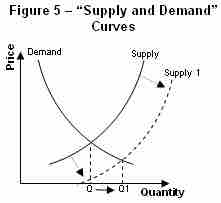Supply is the quantity of a good or service that a supplier provides to the market. Innumerable factors and circumstances could affect a seller's willingness or ability to produce and sell a good. Some of the more common factors are:
- Good's own price: An increase in price will induce an increase in the quantity supplied.
- Prices of related goods: For purposes of supply analysis, related goods refer to goods from which inputs are derived to be used in the production of the primary good.
- Conditions of production: The most significant factor here is the state of technology. If there is a technological advancement related to the production of the good, the supply increases.
- Expectations: Sellers' expectations concerning future market conditions can directly affect supply.
- Price of inputs: If the price of inputs increases the supply curve will shift left as sellers are less willing or able to sell goods at any given price. Inputs include land, labor, energy and raw materials.
- Number of suppliers: As more firms enter the industry the market supply curve will shift out driving down prices. The market supply curve is the horizontal summation of the individual supply curves.
- Government policies and regulations: Government intervention can take many forms including environmental and health regulations, hour and wage laws, taxes, electrical and natural gas rates and zoning and land use regulations. These regulations can affect a good's supply.
Suppliers will change their production levels along the supply curve in response to a price change, so that their production level is equal to demand. However, some factors unrelated to price can shift the production level. For example, a technological improvement that reduces the input cost of a product will shift the supply curve outward, allowing suppliers to provide a greater supply at the same price level.

Determinants of Supply
If the price of a good changes, there will be movement along the supply curve. However, the supply curve itself may shift outward or inward in response to non-price related factors that affect the supply of a good, such as technological advances or increased cost of materials.